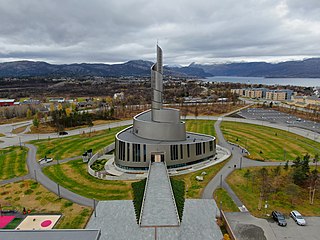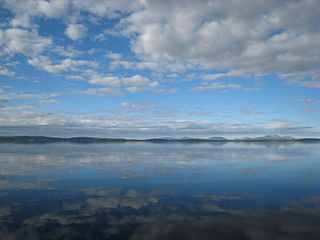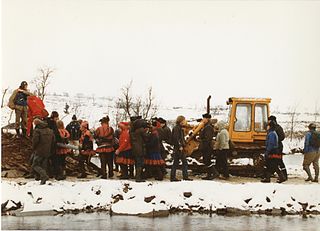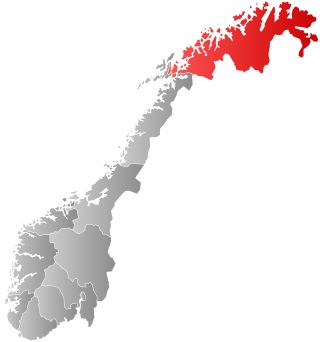
Finnmark is a county in the northern part of Norway.

Kautokeino is a municipality in Finnmark county, Norway. The administrative centre of the municipality is the village of Guovdageaidnu/Kautokeino. Other villages include Láhpoluoppal and Máze.

Alta is the most populated municipality in Finnmark county, Norway. The administrative centre of the municipality is the town of Alta. Some of the main villages in the municipality include Kåfjord, Komagfjord, Kvenvik, Langfjordbotn, Leirbotn, Rafsbotn, Talvik, and Tverrelvdalen.

The Paatsjoki River is a river that flows through Finland, Norway, and Russia. Since 1826, the river has marked parts of the Norway–Russia border, except from 1920 to 1944 when it was along the Finland–Norway border.

Masi (Norwegian) or Máze (Northern Sami) or Maasi (Finnish) is a village in Kautokeino Municipality in Finnmark county, Norway.

The Begna is a river in Buskerud and Innlandet counties in Norway. The 213-kilometre (132 mi) long river runs from the Filefjell mountain area through Valdres to the town of Hønefoss where it joins the river Randselva before it empties into the Tyrifjorden. The river Begna drains a watershed of 4,875 square kilometres (1,882 sq mi) and this is the primary river in the watershed. Along its course, the river passes through the village of Begna in Sør-Aurdal Municipality. The Norwegian writer, Mikkjel Fønhus lived much of his life and located most of his novels along the river Begna.

Drammenselva is a river in Buskerud county, southeastern Norway.

Iešjávri is a large lake on the border of the three municipalities of Alta, Kautokeino, and Karasjok in Finnmark county, Norway. The lake lies on the Finnmarksvidda plateau about 50 kilometres (31 mi) northwest of the village of Karasjok, about 30 kilometres (19 mi) northeast of the village of Masi, and about 45 kilometres (28 mi) southeast of the town of Alta.
Nesjøen is an artificial lake (reservoir) in the municipality of Tydal in Trøndelag county, Norway. The lake is part of the Nea-Nidelv watershed which lies on the western part of the Sylan mountain range. The lake lies about 10 kilometres (6.2 mi) southeast of the municipal center of Ås and 6.5 kilometres (4.0 mi) north of the village of Stugudalen. The lake is good for trout fishing.

Altaelva is the third-longest river in Finnmark county, Norway. The river begins in the mountains and lakes in Kautokeino Municipality, near the border with Finnmark county and Finland, just south of Reisa National Park. The 240-kilometre (150 mi) long river then runs northward into Alta Municipality where it flows out into the Altafjorden in the town of Alta. The river has carved out Sautso, one of the largest canyons in Europe on its way from the high Finnmarksvidda plateau down to the sea. The villages of Kautokeino and Masi are located along the river, in addition to the town of Alta.

Karasjohka (Norwegian) or Kárášjohka (Northern Sami) is a river in Finnmark county, Norway. The 161-kilometre (100 mi) long river runs through Kautokeino Municipality and Karasjok Municipality. The river is one of the most important rivers that drains the Finnmarksvidda plateau. It flows into the famous salmon-fishing Tana River near the Finnish village of Karigasniemi on the Norway-Finland border.

The Alta conflict or Alta controversy refers to a series of protests in Norway in the late 1970s and early 1980s concerning the construction of a hydroelectric power plant in the Alta River in Finnmark, Northern Norway.

The Tuloma is a river in Murmansk Oblast in Russia. With a drainage basin of 21,500 square kilometres (8,300 sq mi) and an average discharge at 255 m³/s, the Tuloma is one of the biggest rivers in northern Fennoscandia.

Ranelva is a 130-kilometre (81 mi) long river in the municipality of Rana in Nordland county, Norway. It is one of the longest rivers in Nordland county. The catchment area of the river is 3,790 square kilometres (1,460 sq mi). Before the power stations of Reinforsen (1925) and Langvatnet (1964) were built, the catchment area was 3,843 square kilometres (1,484 sq mi).
The Finnmark Act of 2005 transferred about 96% of the area in the Finnmark county in Norway to the inhabitants of Finnmark. This area is managed by the Finnmark Estate agency.
Hålogalandsallmenningen is the proposed name for the organization which is expected to manage about 50% of the land and inland water resources in the counties of Troms and Nordland in Norway. It expected that the members in the board of directors will be elected from the County Council of Troms, the County Council of Norland, and the Sami Parliament of Norway. A similar organization, the Finnmark Estate, is already established in the county of Finnmark.

Sautso, also referred as Alta Canyon, is a canyon (valley) along the river Altaelva in Finnmark county, Norway. The valley is located in Alta Municipality, just north of the border with Kautokeino Municipality. The canyon is about 12 kilometres (7.5 mi) long and about 300 to 420 metres deep, making it the largest canyon of Northern Europe. The canyon begins just downstream (north) from the Alta Power Station. The river flows down from the Finnmarksvidda plateau into the canyon, so the walls of the canyon clearly show many sedimentary layers.

Ulla-Førre is a hydropower complex in Southern Norway. It is situated along the borders of the municipalities of Suldal and Hjelmeland and Bykle, Norway. It has an installed capacity of approximately 2,100 megawatts (2,800,000 hp), and the annual average production is 4.45 TWh (16.0 PJ) (1987–2006), while its reservoir capacity is about 7.8 TWh (28 PJ); at full production, it can last seven to eight months. The complex includes the artificial lake Blåsjø, which is made by dams around 1,000 metres (3,300 ft) above the sea level. The hydroelectric power stations in the complex are Saurdal, Kvilldal, Hylen and Stølsdal, operated by Statkraft.

Cathaleen's Fall hydroelectric power station is a hydroelectric plant located on the River Erne at Ballyshannon in County Donegal, Ireland. Also known as Ballyshannon, it is owned and operated by the ESB Group. The plant consists of two Kaplan turbines providing a combined capacity of 45 MW (60,000 hp) within a concrete gravity dam 257 m (843 ft) long. Constructed between 1946 and 1955, it is the larger of two hydroelectric plants built between Belleek and Ballyshannon at the same time. Despite construction of the dam meaning the destruction of Assaroe Falls, a local beauty spot, Camlin Castle and many other dwellings, there was no local or national resistance to the project. It was the Ireland's first act of major co-operation with Northern Ireland since independence. The site appears in Conor McPherson's The Weir, to represent the fictional location in the play.

Troms og Finnmark was a county in northern Norway that existed from 2020 to 2023. The county was established on 1 January 2020 as the result of a regional reform. It was the largest county by area in Norway, encompassing about 75,000 square kilometres (29,000 sq mi), and was formed by the merger of the former Finnmark and Troms counties in addition to Tjeldsund Municipality from Nordland county.


















